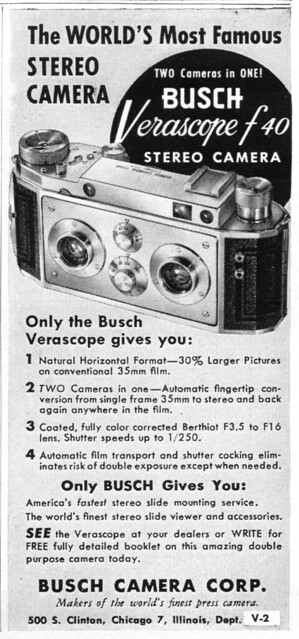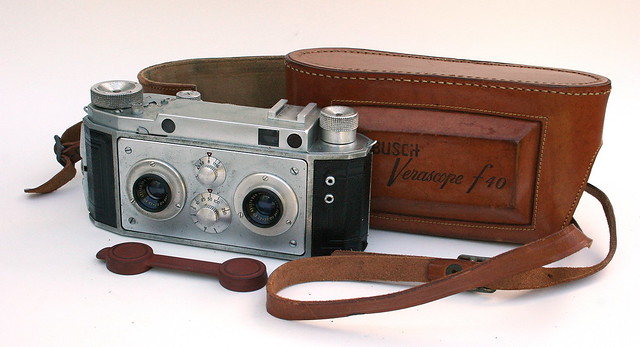Difference between revisions of "Verascope f40"
m (added NeedPhotos) |
Hanskerensky (talk | contribs) (Added Category year of introduction (according to McKeowns 2006 Catalog)) |
||
| (5 intermediate revisions by 5 users not shown) | |||
| Line 1: | Line 1: | ||
| − | + | <div class="floatright plainlinks" style="margin:0px 0px 10px 20px;"> | |
{{Flickr_image | {{Flickr_image | ||
|image_source= http://www.flickr.com/photos/vox/5494657576/in/pool-camerawiki/ | |image_source= http://www.flickr.com/photos/vox/5494657576/in/pool-camerawiki/ | ||
| − | |image= http://farm6.static.flickr.com/5254/ | + | |image= http://farm6.static.flickr.com/5254/5494657576_e1fae354b2_z_d.jpg |
| − | |image_align= | + | |image_align= |
| − | |image_text= Busch advertisement in February, 1952 <i>Popular Photography</i><br/> | + | |image_text= Busch advertisement in February,<br/>1952 <i>Popular Photography</i><br/> |
|scan_by= Voxphoto | |scan_by= Voxphoto | ||
|image_rights= Public domain US no copyright | |image_rights= Public domain US no copyright | ||
| − | }}The '''Verascope f40''' was introduced about 1938, and was designed to take pairs of 24 x30mm images on [[35mm film]]. This superseded the earlier | + | }} |
| + | </div> | ||
| + | The '''Verascope f40''' stereo camera by [[Richard (Jules)|Richard]] was introduced about 1938, and was designed to take pairs of 24 x30mm images on [[35mm film]]. This superseded the earlier and larger glass-plate Verascope models. Model f40 production continued through the 1950s, going through several small revisions. It is considered to be one of the better-finished stereo cameras made, though perhaps inferior to the [[Stereo Realist]]. | ||
The f40 was exported to the US where it was sold by the Chicago press-camera manufacturer [[Busch]]. | The f40 was exported to the US where it was sold by the Chicago press-camera manufacturer [[Busch]]. | ||
This camera can be seen in use briefly in the 1967 film ''Two For The Road''<REF>Most clearly, starting at around 19:40 in the DVD edition. Alfred Finney plays a young architect, who tells Audrey Hepburn's character that his stereo camera is "mostly for buildings." (In fact, subjects near infinity would benefit little from 3-D photography.) The POV shots through the camera viewfinder are not realistic, as the framelines shown correspond to a widescreen [http://en.wikipedia.org/wiki/Panavision Panavision] [[aspect ratio]] instead.</REF>. | This camera can be seen in use briefly in the 1967 film ''Two For The Road''<REF>Most clearly, starting at around 19:40 in the DVD edition. Alfred Finney plays a young architect, who tells Audrey Hepburn's character that his stereo camera is "mostly for buildings." (In fact, subjects near infinity would benefit little from 3-D photography.) The POV shots through the camera viewfinder are not realistic, as the framelines shown correspond to a widescreen [http://en.wikipedia.org/wiki/Panavision Panavision] [[aspect ratio]] instead.</REF>. | ||
| + | |||
| + | |||
| + | {{Flickr_image | ||
| + | |image_source= http://www.flickr.com/photos/26262745@N08/7770739028/in/pool-camerawiki/ | ||
| + | |image= http://farm8.staticflickr.com/7260/7770739028_227f187ab0_z.jpg | ||
| + | |image_align= left | ||
| + | |image_text= Verascope f40, branded by Busch for sale in the USA. | ||
| + | |image_by= Rick Oleson | ||
| + | |image_rights= with permission | ||
| + | }} | ||
| + | <br style="clear:left;"/> | ||
| Line 17: | Line 30: | ||
<references/> | <references/> | ||
| − | + | {{br}} | |
| + | == Links == | ||
| + | *[http://www.butkus.org/chinon/verascope/verascope_f_40.htm Verascope PDF manual] from [http://www.butkus.org/chinon/ www.OrphanCameras.com] | ||
| + | |||
| + | [[Category:France]] | ||
| + | [[Category:Stereo]] | ||
| + | [[Category:35mm stereo]] | ||
| + | [[Category:V]] | ||
| + | [[Category:1938]] | ||
Latest revision as of 05:49, 22 January 2024

|
| Busch advertisement in February, 1952 Popular Photography scanned by Voxphoto (Image rights) |
The Verascope f40 stereo camera by Richard was introduced about 1938, and was designed to take pairs of 24 x30mm images on 35mm film. This superseded the earlier and larger glass-plate Verascope models. Model f40 production continued through the 1950s, going through several small revisions. It is considered to be one of the better-finished stereo cameras made, though perhaps inferior to the Stereo Realist.
The f40 was exported to the US where it was sold by the Chicago press-camera manufacturer Busch.
This camera can be seen in use briefly in the 1967 film Two For The Road[1].

|
| Verascope f40, branded by Busch for sale in the USA. image by Rick Oleson (Image rights) |
Notes
- ↑ Most clearly, starting at around 19:40 in the DVD edition. Alfred Finney plays a young architect, who tells Audrey Hepburn's character that his stereo camera is "mostly for buildings." (In fact, subjects near infinity would benefit little from 3-D photography.) The POV shots through the camera viewfinder are not realistic, as the framelines shown correspond to a widescreen Panavision aspect ratio instead.